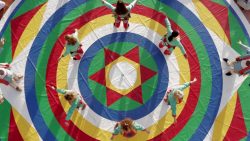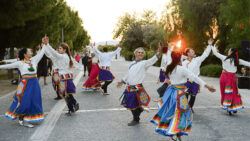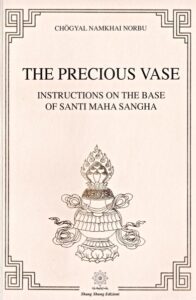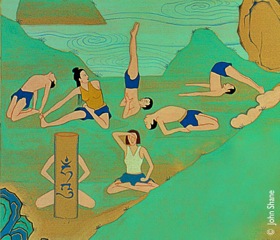Dzogchen
Dzogchen is an ancient spiritual teaching developed in Tibet within the Tibetan Buddhist tradition. It does not belong to a school or religious system. Rather, it is the knowledge that Tibetan masters have transmitted without being limited by sectarianism. The word Dzogchen, meaning total perfection, actually refers to the true inherent nature of all beings, their primordial state, which is free from all limitations and conditioning. The master’s transmission of this state of knowledge lies at the very heart of the Dzogchen teachings. The Dzogchen tradition has been passed from master to student in an unbroken lineage over the centuries, right up to the present day. Due to its direct approach, it transcends cultural boundaries making it accessible to all nationalities regardless of their spiritual background
Santi Maha Sangha
Santi Maha Sangha is a course of study and practice in nine levels initiated by Chögyal Namkhai Norbu in 1994. The aim of Santi Maha Sangha, which in the ancient language of Oddiyana means “Dzogchen Commmunity,” is to guarantee the continuation of the Dzogchen teaching as it was originally transmitted by Garab Dorje, and as the Master transmitted for more than thirty years within the Dzogchen Community. The SMS Training includes the complete teachings of Garab Dorje and the related instructions to deepen the knowledge of Semde, Longde and Upadesha through study and practice, and also includes the essential theory and practice of Sutra and Tantra. The Santi Maha Sangha Training is very important to guarantee the continuity of the Dzogchen knowledge and teaching: taking this commitment means pursuing our own benefit and the benefit of all sentient beings.
To know more: Chögyal Namkhai Norbu about SMS: Rinpoche-on-SMS-ENG-2008
Yantra Yoga
Yantra Yoga or the Yoga of Movement, is one of the oldest recorded systems of Yoga that exists in the world. It is a system of Yoga that has come to us through Tibet, a land full of a vast and rich traditional Buddhist knowledge and wisdom.
This uninterrupted lineage of Yantra Yoga is a fundamental method to integrate the profound essence of the Dzogchen Teaching in the three doors (body, voice and mind) of the practitioner. Through positions and movements combined with breathing, one’s energy is coordinated and harmonized so as to let the mind relax and find its authentic balance, which is the basis for contemplation.
In Yantra Yoga there are many positions similar to Hatha Yoga, but the way to assume them differs. In Yantra Yoga a sequence of seven phases of movements connected to seven breathings is used. In particular, in the central phase of the movement the position helps create specific retentions of the breath that work at a subtler and deeper level. For this reason it is not only the main position but the entire movement that is important. Chögyal Namkhai Norbu has written an extensive commentary on the root teachings by Vairocana from the 8th century, Nyida Khajor, the Union of Sun and Moon Yantra, based on his personal training and knowledge of Yantra Yoga received from his uncle and various teachers in Tibet. Chögyal Namkhai Norbu began teaching Yantra Yoga in the beginning of the 70’s in Italy.
For more information on Yantra Yoga please visit: https://yantrayoga.net/about
Vajra Dance

In the Dzogchen Teaching sound and movement are very important because they are the means to integrate oneself into the state of contemplation. The Vajra Dance is principally a practice to harmonize the energy of the individual. If one has a more profound knowledge of the meaning of the Dance, it becomes a method for integrating the three existences of body, voice and mind into the knowledge of the state of contemplation. This integration is one of the most important aims of a Dzogchen practitioner. The Vajra Dance is practiced on a Mandala which represents the correspondence between the internal dimension of the individual and the outer dimension of the world.
For more images and information, visit http://vajradance.net
Khaita

KHAITA MEANS “HARMONY IN SPACE”. “Kha” means “space/sky” and “Ta” means “harmony/melody”. While dancing, we learn to be present to the inner display of thoughts and emotions. As we cultivate this relaxed presence in movement, harmony and joy develop naturally. This continues in our life, moving more easily through our routines, activities and daily tasks.
Khaita, Harmony in Space is a project created in 2011 by Chögyal Namkhai Norbu. It unites the two aspects that most characterized his life: his unparalleled activity and wisdom as a Dzogchen Master and his great erudition in all fields of Tibetan culture. “It’s better to live in melody… if we dance and sing we feel more joyful and we can also relax.”
For more information, visit https://khaita.org/



